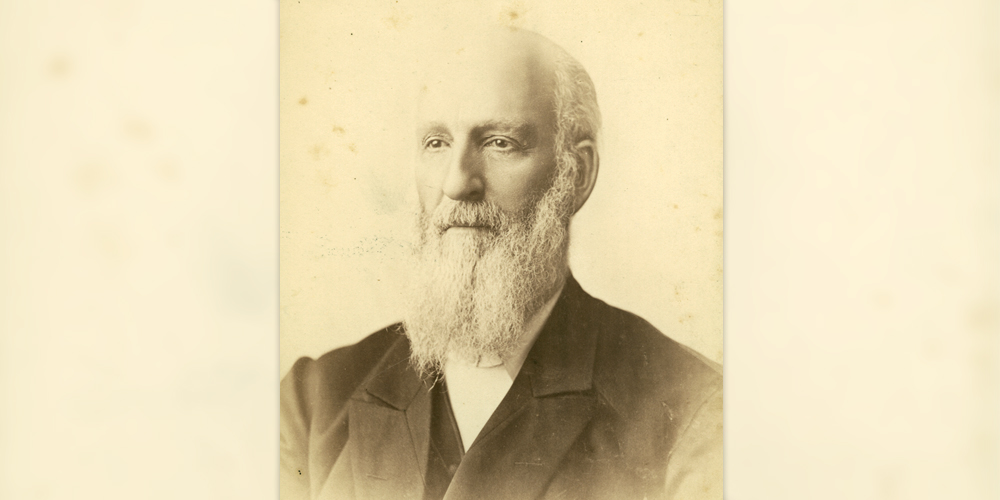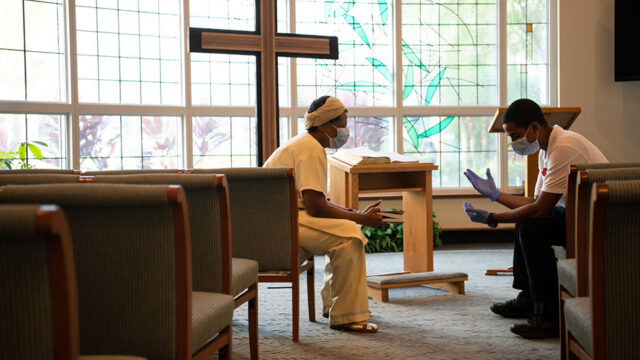Today his influence still is being felt, and the impress of his shaping hand still is seen.

This article first appeared in the Adventist Review, August 13, 1981 noting 100 years since the death of James White. It was the second in a two-part series entitled, “The Death of a President.” We include it for your reading pleasure because it references James White’s parents, Deacon John and Betsy White. While not prominent pioneers in the Adventist story, the couple raised a son in the faith, and in turn chose Adventism later in life. Please click the link https://www.artvnow.com/videos/john-and-betsy-white to watch a short video about their home in Battle Creek, Michigan.—Editors.
Deacon John White and his wife, Betsy, watched sympathetically as their son James Springer, middle child in their family of nine, left the house for a day of work plowing the rocky, exhausted soil of the Maine family farm. They noted his puny appearance and thought back to the day of his birth—August 4, 1821. He had been a healthy baby, but a few years later a childhood illness had almost cost him his life. As a result he had become sickly, with damaged eyesight. Perhaps John and Betsy felt that this handicapped son might remain on the farm, a comfort to them in their old age. Certainly he could never aspire to any career that might cause eyestrain. His eyes were badly crossed, and he was obliged to rest them after reading as little as two lines of Scripture.
Shortly before James’ eighteenth birthday something like a miracle occurred. It may have been the bracing Maine climate, the physical toil on the farm, the nourishing food prepared by his mother and sisters, or perhaps a combination of the three. His eyesight cleared, and he grew in height and strength. Soon he could look down on most of his peers. Embarrassed but determined, the tall, awkward youth who, as he stated, “could not tell a verb from an adverb or an adjective” or “work a simple problem in single rule of three” (James White, Life Incidents [Paradise Press, 1972], pp. 12, 13), entered the academy at St. Albans, about five miles from his Palmyra, Maine, home. He was 19, and this was his first formal schooling.
Amazingly, after 12 short weeks of concentrated study, he was given a teaching certificate, and during the winter of 1840-1841 presided over a country school. He had to study long hours to keep ahead of his pupils. With unabated thirst for knowledge, he next attended a more advanced school, delving into such subjects as natural philosophy, algebra, and even Latin. One term there ended his formal education. Describing this era in his life, James White wrote, “I have attended high school, in all, twenty-nine weeks, and the entire cost of tuition, books, and board, has not exceeded fifty dollars.”—Ibid., p. 14.
James was firmly convinced that he had found his lifework. He would be a teacher. In the second school he taught there were 50 students, 20 of whom were near his age, and several even older. He wrote, “I loved my scholars, and this love was mutual.”—Ibid., p. 18.
But God had other plans for James White. In 1842, during summer vacation, he came home to find that some members of his family and several classmates had accepted the preaching of William Miller. His mother began talking with him about religion. James had been baptized at the age of 15, mostly to please his father, who was a deacon in the Christian Church. At first the young man deplored his mother’s interest in the Second Advent doctrine, calling it “wild fanaticism.” But as he studied and prayed, the conviction came to him, “This is the truth.”
After attending two Adventist camp meetings, he made his decision. He must spread the tidings. A world out there was waiting to be warned.
His first effort was for the students he had taught. Encouraged, he wrote, “My testimony reached the people, especially my scholars and their parents. The following summer, lectures were given in the town-house [at Troy], and the next winter most of the people of that town embraced religion.”—Ibid., p. 23.
Go Out Into the Harvest-Field
After attending a Millerite camp meeting in Exeter, Maine, James’ conviction that he must “immediately go out into the great harvest-field” was strengthened, and he set forth on horseback from his father’s house, “snugly buttoned up” in his overcoat, to face a Maine winter.
A few weeks later he experienced persecution. While speaking in a schoolhouse, he was assailed by a yelling mob of 300 who pelted him with snowballs hurled through the open windows of the building. The evening before, a large spike had been thrown, wounding his forehead. Above the tumult he cried out, “‘Repent and be converted, that your sins may be blotted out. . . . Turn to Christ and get ready for His coming, or in a little [while] from this, on rocks and mountains you will call in vain.’”
He continued, “‘Some poor sinner cast this spike at me last evening. God pity him. The worst wish I have for him is, that he was this moment as happy as I am. Why should I resent his insult when my Master had them driven through His hands?’”—Ibid., p. 78. He stretched his arms against the wall behind him in the position of Christ on the cross. The mob fell silent, and nearly 100 persons in that company made their decision to accept Jesus as their Savior. Before the close of that wintry tour, James White reported that “one thousand souls dated their experience from my lectures during that six weeks.”—Ibid., p. 96.
Among the waiting ones, hope ran high. But October 22, 1844, came and went. Christ did not appear. James White “wept like a child.”
But God had not forsaken His people. The disappointed ones studied their Bibles and were comforted. “He that shall come will come, and will not tarry” (Heb. 10:37, KJV) was a promise to which they clung. New light came, and they understood that the sanctuary to be cleansed was in heaven, not on earth.
During this period James had met and admired a young woman named Ellen Harmon. On August 30, 1846, they became husband and wife. Ellen and James complemented each other, James leading out in the organization of a church and Ellen bearing inspired messages of encouragement, guidance, and correction that would bring success to their work. In spite of incredible poverty, the young couple set forth together with but a single aim—to spread the message, to warn a world of Christ’s near appearing.
Soon after their marriage, as a result of intense study, they became convinced that the seventh day was God’s true Sabbath. This decision took courage, for in their home state, Maine, there were only about 25 Sabbath-keeping Adventists, and only about 50 in all New England.
Both husband and wife were gifted speakers, but some “preferred to hear her, because she talked so much about Christ and salvation and getting ready for heaven. Very properly, Elder James White had a great deal to say about our sins and about the heat of the ‘hot place’ to which sinners would be finally condemned.”
A gifted singer, James White sometimes utilized a unique method of gaining the attention of his congregation. Elder W. A. Spicer remembered “sitting in our church waiting for the preacher. Our backs were to the street door, through which the minister would enter. Then suddenly the silence would be broken by a sweetly musical and strong, sure voice, singing a familiar hymn. I can see the singer now, James White, . . . coming down the aisle, beating time on his Bible, and singing, ‘When I can read my title clear . . .’”—W. A. Spicer, Pioneer Days (Review and Herald Pub. Assn., 1946), pp. 146, 147.
Stepped Out in Faith
Preaching, however, was local, and “the world was our field of labor,” James White wrote. “As there were so few to stand before the people as teachers of the present truth, very much of the work must be accomplished by the press.”—Review and Herald, July 19, 1881. Through this personal conviction and in response to a vision given Ellen, during which she was instructed that a paper must be started, James stepped out by faith and began publishing a small pioneer periodical, Present Truth, the first issue bearing the date July 1849. The next year volume 1, number 1, of the Second Advent Review and Sabbath Herald was published in Paris, Maine.
In 1852, James White started a paper for young people, The Youth’s Instructor. A monthly, it carried a subscription price of 25 cents for 12 numbers. Two years later, it was announced that the price of the Review and Herald would be one dollar a year. “‘I must see the publishing work prosper,’” James White declared. “‘It is interwoven with my very existence. If I forget the interests of this work, let my right hand forget her cunning.’”—Ellen G. White, Testimonies for the Church (Pacific Press Pub. Assn., 1948), vol. 1, p. 107.
The next logical step was the purchase of a printing press. “In October, 1852, the Review and Herald announced that the cost of press and equipment had been $652.93, and the receipts for the purpose $655.84. Thus, before the work was eight years old, before there was any organization of any kind, before there was any means of support except voluntary contributions, the publishing work of the new cause was launched on a basis—for that time—fairly firm.”—A. W. Spalding, Captains of the Host (Review and Herald Pub. Assn., 1949), pp. 186, 187. James White’s new venture was located in Rochester, New York, where it remained until the fall of 1855. Then, almost before the ink had dried on the copy of the October 30 Review of that year, the machinery was shipped by rail to Battle Creek, Michigan, followed by the group of workers who had shared the large Rochester house with the press.
The move to Battle Creek was significant. A two-story, 20-by-30-foot frame building erected for the purpose became the first Review and Herald Publishing Association. From this modest beginning the plant expanded, until by 1881 it was “the largest and most complete plant in the State”—A. W. Spalding, Origin and History of Seventh-day Adventists (Review and Herald Pub. Assn., 1961), vol. 1, p. 270.
James White was an astute businessman. If it had not been for his “keen perception, informed sometimes by divine warnings, the precious funds of the forming church and its one institution would have been lost” (ibid., p. 272).
The proliferating groups of believers trusted their leader; but when Elder White stated that some sort of organization was essential in order to bind the scattered flock together, opposition arose. Some, having come out of organized churches when they joined the Millerite movement, were skeptical of the need for any form of organization. James White, however, declared: “’We lack system. . . . The lack of system is felt everywhere.’”—Virgil Robinson, James White (Teach Services, Inc., 2000), p. 152. There had to be a uniform salary scale. The question also arose, Who would own church property? Should James White continue as legal owner of the Battle Creek publishing plant? Finally, in October 1860, a plan of organization was adopted, and the church was given a name—Seventh-day Adventists.
There was another important question: Who would head the newly formed body? In May 1863, a General Conference was organized, and James White was invited to serve as president. He declined, politely and firmly. The delegates accepted his refusal and chose John Byington, a respected minister from New York State, to head the church body. Later, James White did accept the position, serving for an aggregate of ten years.
After that, a veritable growth explosion ensued. James and Ellen traveled to the point of exhaustion, visiting churches, meeting speaking appointments, encouraging the believers. James’ brother John, a Methodist minister in Ohio, finding it impossible to understand such pressures, wrote, “You must have taken the great commission ‘Go ye into all the world’ literally. You are as orthodox as John Wesley, who declared, The world is my parish. Texas is it now—where do you pay your taxes, and get your washing done? . . . Watch your physical strength and mental process, and quit in time. There is heroism in contented quiet, as in incessant toil.”—John White to James White, Feb. 15, 1875, Document File 715-b. “It makes me nervous to read California, Kansas, Battle Creek, Maine, and the rest of it. Do settle down, man, and keep quick [alive]. Learn from your elder brother the art of being comfortable.”—Ibid., April 23, 1875, Document File 715-b. “You will bring that perpetual motion of a body of yours to an anchor by and by. If you don’t, death will. Would it be possible for you to live an hour in a state of physical and mental repose? Don’t know. It was never tried. . . . Write often. Would as soon try to keep track of chain lightning as you.”—Ibid., Sept. 17, 1878, Document File 715-b.
House Overflowed With Visitors
James and Ellen did have a home, and when they could rest between appointments, they thoroughly enjoyed it. The house was more often than not overflowing with visitors—traveling preachers, relatives, indigent members, their sons’ friends, or orphan children. The openhearted James “would take them to his own house till every chair and bed was full, then he would go to his brethren and have them take those whom he could not. If they needed means, he would give to them and invite others to follow his example.”—Testimonies, vol. 1, p. 677.
He also brought his and Ellen’s parents to Battle Creek, where they lived out their days under the benevolent care of their children. Old Deacon John, happy to leave Palmyra, wrote that he had spent nearly “all of life that amounts to anything in labour where the husbandman is so poorly rewarded”—John White letter, June 7, 1856, Document File 715-b.
Home was indeed a happy place, a place of rest, but even there sorrow and joy were intermingled. James and Ellen had buried their “sweet singer,” 16-year-old Henry, and then their baby, John Herbert, in the Oak Hill Cemetery in Battle Creek. Two surviving sons, James Edson and William Clarence, grew to manhood in the White home on Wood Street in Battle Creek.
With the passing of the years, however, Elder White became exhausted. A series of strokes gradually weakened him, and he pleaded for younger men to step in and help carry the load, but he had difficulty laying off the burdens. From November 1878, until April 1879, he and Ellen made their home in Texas. But by the summer of 1879, they were again busy with the camp-meeting program.
At the 1880 General Conference Session, the man “who had during three separate periods carried the burden of the presidency, laid it down with finality.” His ambition now was to devote time to study, writing, “and the cheering and inspiring of his people and his fellow workers”—Spalding, Origin and History, vol. 2, pp. 213, 214.
Was James White perfect? “He was a hard worker. He drove himself. Perhaps some under his influence felt that he was a driver of others. He had his share of counsel and correction from the Spirit of Prophecy. We are not to surround our early men with any suggestion of an atmosphere of human perfection. They were strugglers, as we all are.”—Spicer, op. cit., p. 155.
Writers have used many adjectives to describe this man—exuberant, outgoing, majestic, dedicated, jovial, earnest, and stern at times are only a few of them. But no one ever honestly accused him of being mean, selfish, narrow, vindictive, or grasping. In his determination to “ripen for heaven,” he wrote to his family 15 months before his death, “I shall take it easy, and grow old gracefully, and make you all love me half to death.”—James White letter, May 20, 1879.
In late July of 1881, as James and Ellen rode along in their carriage on the way to a Michigan camp meeting, they spoke of God’s mercies and His guidance in their lives. Ellen never forgot that ride, for it was the last journey the two would take together.
Less than two weeks later, on the evening of the blessed Sabbath, he quietly breathed his last.
In his funeral sermon, Uriah Smith said: “God buries the workman, but still carries on the work. His influence will still be felt, the impress of his shaping hand will still be seen, and all the future workings of this cause will revive and keep alive his memory.”—Ellen G. White, Memoriam: A Sketch of the Last Sickness and Death of Elder James White (Review and Herald Pub. Assn., 1881), p. 36.
How right Elder Smith was. One hundred years have passed, but Seventh-day Adventists still honor James White, and God has carried His work forward more successfully than Elder White could possibly have imagined.








